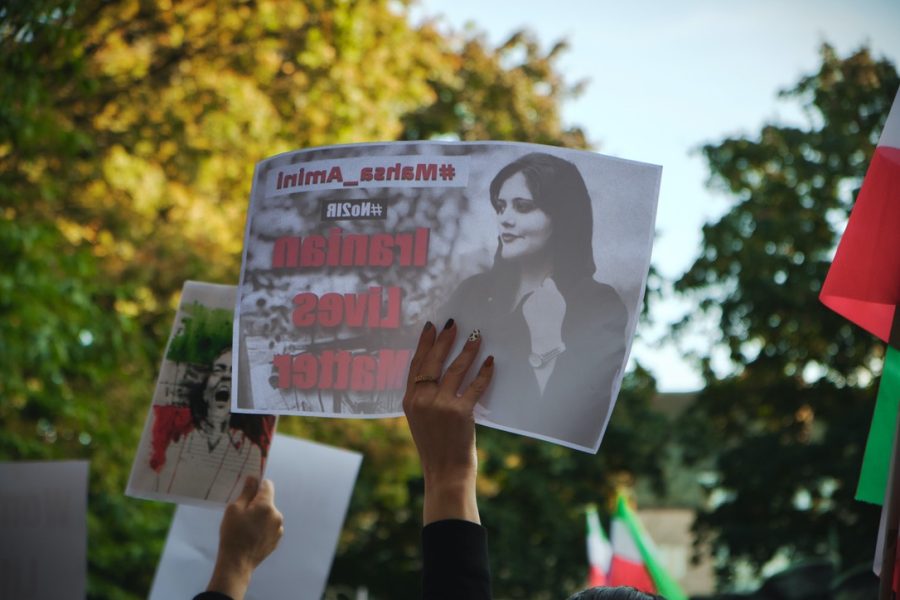‘Women, Life, Freedom’: Death of 22-Year-Old Mahsa Amini Sparks Global Protest
The mysterious death of a 22-year-old Iranian woman while in her government’s custody has sparked a global conversation about feminism and Iran’s current theocratic rulers.
Artin Bakham / Unsplash / Licensed for free use by Unsplash
On Wednesday, Oct. 5, protestors rally in the streets of Stockholm, Sweden, many holding up pictures of Mahsa Amini. Similar protests have erupted all over the globe against the Iranian government’s response to and possible involvement in Amini’s death.
October 15, 2022
On Friday, Sept. 16, in Tehran, Iran, 22-year-old Mahsa Amini died after an allegedly violent encounter with the country’s morality police.
Before her untimely death, Amini was at the mall with her brother. Morality police arrested Amini, a Muslim woman and Iranian citizen, for not properly wearing her hijab. There is evidence that police then physically abused her, after which she fell into a coma and later died.
The Iranian government claims that Amini died as a result of natural causes. However, this contradicts eyewitness accounts of Amini’s detainment, as well as the account given by Amini’s family.
In response to Amini’s death, women and men all over Iran have engaged in protests against Amini’s treatment and the country’s treatment of women in general.
Amini’s story has sparked one of the biggest protest movements in Iranian history that’s now spread throughout the world. Not only are women in Iran displaying their anger with their government by cutting their hair and removing their hijabs, but women all over the globe have also followed suit.
These trends continue to gain traction on TikTok, a popular social media platform, as a way of remembering Amini and the symbol of feminism she represents:
@parasta_marandi #mahsaamini #freeiran #iran #prayforiran #freedom ♬ original sound – emma🤍
Advocates of change argue that Iranian women should have the power to express themselves freely and without restraint from government bodies such as the morality police.
For the rest of the world, Amini’s death shed light on the reality of Iran’s theocracy-based government, in which religious figures hold an incredible amount of political power. However, any observers who see the current protests as religious criticism are ignoring several decades of political turmoil brought to Iran by outside forces.
In 1953, a coup reinstated the Shah of Iran, a member of the Iranian monarchy, after overthrowing Premier Mohammad Mosaddeq, who was elected by the country’s National Assembly.
In 1979, a confluence of factors including protests drove the Shah to leave Iran permanently, and in April of the same year, the country voted to approve a referendum to establish Iran as an Islamic Republic with a theocratic-republican constitution. This transition is now known in the U.S. as the Iranian Revolution.
A South student with Iranian heritage provided their perspective concerning the current criticism of Iran’s government in the wake of Amini’s death, identifying the nuances of theocracy as a key point to understand the most recent protests.
“Regarding the theological disruption occurring in Iran, I believe people have the right to protest for Mahsa [Amini’s] death, but I don’t believe they have the right to burn and harm religious symbols,” the student said. “The government of Iran is the problem, not Iran, but unfortunately their methods of protesting are causing the world around them to believe that Islam [the dominant religion in Iran] is a problem.”
The student, who identifies as Muslim, denounced the actions of Iran’s morality police as directly contravening the teachings of Islam.
“The morality police have always been wrong,” said the student. “Iran’s method’s of implementing Islam in their government diminishes the true values of Islam. The morality police [are] simply an excuse for them to maintain control of the Iranian people. The morality police have nothing to do with the true rules of Islam.”
The student believes that focusing on the Iranian government itself, rather than its cultural or religious elements, is the only way to create an outcome that will truly benefit the people of Iran.
“In my opinion, I believe change will take place, but not until society accepts the true meaning of the message coming from this revolution,” the student said. “Until society unanimously agrees that the only issue is the government itself, there will be no true change. The motive will continue to remain a wrong motive for ‘saving’ the people of Iran.”
Watch students at Hormozgan University in Iran tear down the gender segregation barrier at their school cafeteria, amidst nationwide protests over the death of Mahsa Amini in police custody ⤵️ pic.twitter.com/wa4sdQ9SsU
— Al Jazeera English (@AJEnglish) October 31, 2022
Ultimately, Amini’s tragic death will go down in history for providing path for Iranian citizens to convey their dissatisfaction with the current Iranian government, and may have opened a door to a new future for women in Iran and all across the world.





